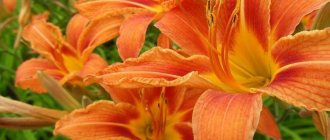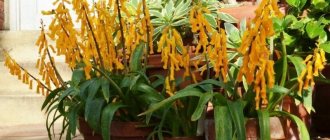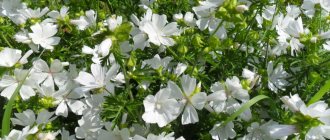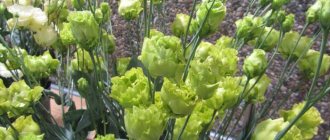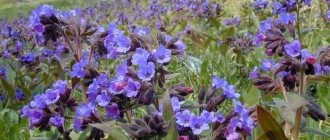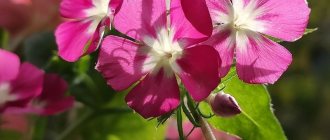Unrelated flowers similar to lilies - order Asparagusaceae
Of course, there are flowers in the world that look like lilies, not from the Liliaceae order, and we have prepared for you some plants with photos and names.
We have chosen families, among which there are beautiful and unusual flowers.
Hesperocalisaceae . Hesperocallis is a lily-like flower on a thick stem.
Hesperocallis - a desert inhabitant with a beautiful flower
.
Ixiolirionaceae
Ixiolirion Tatarian - amazing beauty!
.
Among the Irisaceae , in addition to the familiar iris (“cockerel”), Watsonia can be distinguished.
Watsonia
.
Xanthorrhoeae family deserves special attention thanks to the genus Daylily. Various types of daylilies are very popular among our gardeners and are highly decorative.
At the moment, there are a great many varieties of daylilies with flowers of different colors.
Yellow daylily (Hemerocállis lílioasphodélus) also known as yellow lily or red lily
.
Among the Prolesaceae , hyacinths are very similar to lilies.
Especially for lovers of lilies with small flowers, we recommend growing oriental hyacinth. Flowers similar to small lilies are not difficult to care for and grow.
- Oriental hyacinth is highly decorative with a strong and at the same time pleasant aroma.
Hyacinth is suitable for growing in winter and cutting for bouquets, and is also one of the most popular house flowers.
There are more than 300 varieties of hyacinth with different colors: white (Inosans), pink (Pint Pearl), blue (Miosotis) and red (Jean Beauce). Hyacinth blooms for about 12-16 days.
This flower is similar to small lilies, usually 15-25 cm in height with shiny and succulent leaves. The flowers themselves are bell-shaped in cylindrical inflorescences.
Black hyacinth
.
Amaryllis family: champion among lily-like flowers
The amaryllis family includes more than 60 genera, of which there are a large number of flowers resembling lilies.
AMARILLIS AND HIPPEASTRUM
We have separated these two genera, as flower growers often confuse them. Amaryllis and hippeastrum are similar in appearance, have large bulbs and thick peduncles with “umbrellas”.
According to the official classification, the Amaryllis genus includes one species - Amaryllis belladonna. Amaryllis belladonna is a rather rare plant and is not widely distributed among domestic flower growers.
Much more often you can find hippeastrum, which some sellers knowingly or unknowingly sell under the guise of “amaryllis”. Hippeastrum is well suited for growing as a potted crop and for cutting.
What flowers bloom after lilies?
Between the lily bushes you can plant asters, delphiniums, daisies or gladioli. A good background for blooming lilies is created by such low plants as: perennial iberis, alyssum, low-growing marigolds (do not pull them out by the roots in the fall, cut the stem with a knife), garden carnations, heucheras.
Interesting materials:
Why the tides? Why does the battery swell? What does GDP depend on? What do you need to open a kindergarten? I’m opening an individual entrepreneur, how to do accounting? Where are the white nights from? Where does the concept of Tutoring come from? Where does aluminum come from? Where does E. coli come from? Where does peat come from?
Red flowers similar to lily: amaryllis, hippeastrum and wallotha
As we have already said, amaryllis is represented by one species. This red lily-like flower is native to South Africa and grows to 50-70 cm in height.
Amaryllis belladonna has excellent decorative qualities, a very beautiful and bright flower.
Bright red amaryllis in a chic bouquet.
It is worth noting that there are garden forms not only with red flowers, but also with pink (Amaryllis belladonna major), light pink (Amaryllis belladonna minor).
HIPPEASTRUM
As mentioned above, amaryllis and hippeastrum are very similar to each other, and at the same time similar to lilies. Hippeastrum has beautiful large flowers.
The genus includes more than 75 plant species, which mainly grow in the tropical and subtropical climate zones of America.
- With the development of floriculture, many garden forms appeared. Hybrid varieties of hippeastrum are distinguished by a variety of colors.
Hippeastrums in red, orange, pink, white and purple colors are widely found.
Blooming hippeastrum
WALLOTA IS BEAUTIFUL
The Wallota flower is native to Africa and is a relative of the amaryllis. The plant has a smaller bulb size and narrower and longer leaves.
Flowers are mainly found in red shades, sometimes white and pink. Wallot is an unpretentious plant and easy to care for.
- For abundant flowering in summer, neither a cramped pot, a cold room, nor dry soil in winter will interfere with it. It grows very quickly so that you definitely won’t have a shortage of flowers.
When the children are separated from the mother bulb, the number of flowers increases even more. Small valottas bloom in the second year.
This indoor flower is similar to a lily in the shape of its inflorescences and gives no less positive emotions.
In summer, the plant loves light and water; it is not demanding on the soil. Ideally, grow in a mixture of turf and deciduous soil with river sand and humus. In winter, the main thing is to provide moderate watering; the flower can withstand up to +5-7 degrees.
Vallota the Beautiful
White indoor flower Eucharis - Amazonian lily, photo
Nowadays, a bulbous house flower with wide dark green lanceolate leaves, blooming with white fragrant flowers similar to a daffodil, is very common among gardeners. Not everyone knows the name of this unpretentious indoor flower, and sometimes it is confused with other flowers.
Blooming eucharis
I also grow this flower and twice a year it pleases me with large snow-white flowers on a long peduncle. The name of this flower is Eucharis or Amazonian lily. Some gardeners call it Eucharis amazonica, and in a 1953 floriculture book it is listed as Eucharis. Blooming eucharis looks very impressive, but even without flowers the large leaves of eucharis look beautiful.
Eucharis is a bulbous indoor or greenhouse flower of the Amaryllidaceae family. Origin: tropics of South America. Eucharis amazonica or Eucharis grandiflora are grown indoors.
Eucharis flower and buds
Eucharis (Amazon lily) - home care
Why doesn't eucharis bloom at home? Despite its apparent unpretentiousness, eucharis requires certain conditions for flowering. First of all, this plant needs nutritious soil, preferably fibrous turf with an admixture of rotted manure, peat and sand.
Watering is moderate, and in February and August, watering is significantly reduced, since the plant is in a state of relative dormancy. In winter, it is advisable to keep eucharis at a temperature of 15-18 degrees, that is, on a cold northern windowsill away from the heating radiator.
To make eucharis bloom faster, place the flower pot on a warm, light windowsill (it is better to raise the temperature by 5-8 degrees), but the flower still does not like direct sunlight. It also does not like drafts, as well as dry air, since it is a tropical plant.
Eucharis blooms
Eucharis is a bulbous plant and reproduces by baby bulbs. But when replanting, you should not separate all the baby bulbs from the plant, because eucharis planted without children will not bloom until new bulbs are formed.
If the conditions for keeping eucharis are suitable, it will bloom 2 times a year: the first time from October to winter, and the second time in April-May.
Eucharis transplantation is recommended during the dormant period, no more than once every 3-4 years. Replant without shaking off the earthen ball. The pot is taken a little wider and deeper than the previous one. It is advisable to add a layer of expanded clay or other drainage to the bottom of the pot.
I photographed a blooming eucharis in my sister's apartment, it is simply magnificent! This flower with large leaves looks best alone. In addition, not all indoor flowers tolerate the close proximity of eucharis.
Eucharis flowers
Eucharis on the windowsill
Author Olga Bogach
Plants similar to lilies, only small
There are plants whose buds are very similar to lily flowers, but their sizes are much smaller.
Erythronium (kandyk)
Perennial kandyk is a herbaceous plant that produces a shoot from a bulb. Its height reaches about 40 cm, and its appearance is 2 opposite leaves growing at the base and a single shoot, at the end of which a flower bud is formed.
Lily-like flowers
Description
Erythronium produces flowers that look like small lilies. They are drooping and have 6 petals, which form a bell-shaped bowl at the base, and at the edges they diverge to the sides and bend back.
The color can vary and is most often pink, yellow or white. It is the varied colors of this plant that make it possible to form a fairly colorful flower bed when grown in open ground.
Note! In mid-summer the stem and leaves die off. Therefore, when forming a flower bed, it is necessary to take this feature into account and combine them with other types of plants.
Goose onion
It also belongs to the lily family. Its homeland is Africa. Continuous work on plant selection has made it possible to develop more than 100 subspecies.
What does a goose onion look like?
The appearance of the plant is characterized by short stature. Its leaves are slightly elongated and its protruding stem is short. The total number of flowers that can be formed from one tuber reaches 10 pieces. They are distinguished by their small size and very delicate petals of a bright yellow color, for which they have received the popular name “lemon snowdrop”.
The height of goose onions can vary from only 3 cm to 30 cm, depending on the growing conditions created. Therefore, it is good to use it in flower beds as a covering plant.
Ixiolirion
Such small flowers, similar to blue lilies, produced by the plant Ixiolirion Tatarian, can rarely be found in personal plots. But the plant is so unpretentious that even with minimal care it will bloom for almost 1 month.
How Ixiolirion blooms
The plant produces a straight stem to a height of up to 0.5 m. If the growing conditions are unsatisfactory, the height will be only 20-30 cm. At the end of the stem, small inflorescences are formed, combining from 2 to 10 flowers, each of which can reach 5 in diameter centimeters.
The petals can be different shades of blue - from lavender to piercing blue.
Hesperocallis
This plant is better known as the “lily of the desert.” Its homeland is the southern tip of North America.
Why does Hesperocallis look like a lily?
The plant has a fairly thick stem with small and sparsely spaced narrow and long leaves. At the top, buds are formed, which gradually bloom into large flowers, reaching a diameter of up to 8 cm.
The color of the petals can vary from snow-white with a silvery tint to greenish tones.
Hesperocallis performs best on loose soils that are highly permeable to moisture.
They need to be watered only in the spring months, while in the summer it should be kept to a minimum. And only when the flower is ready to release a bud, it is necessary to water the “lily of the desert”, after which it will bloom profusely.
